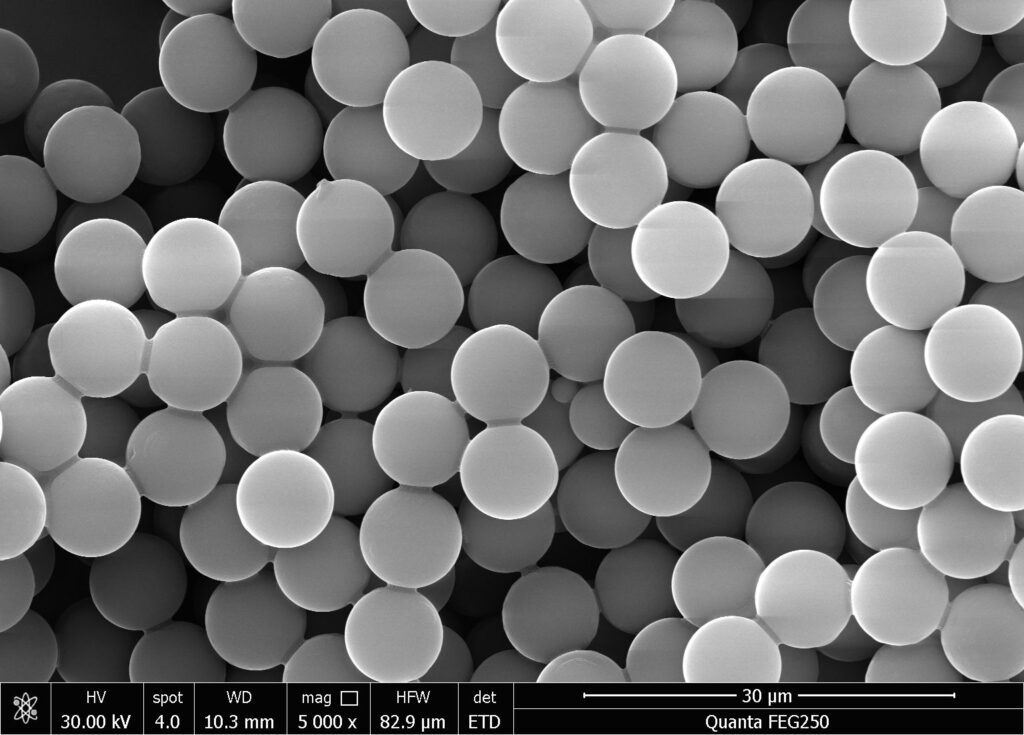مقدمة عن حبات ستريبتافيدين المغناطيسية
Streptavidin magnetic beads (SA beads for short) refer to magnetic microspheres with specific bioactive substances (streptavidin) modified on their surface.Streptavidin magnetic beads are a type of biological nanomagnetic beads with a surface functional group of streptavidin. They can specifically bind to biotin or biotin labeled molecules, thereby separating biotinylated molecules. The strong binding and multi-level amplification effect of biotin avidin with labeling reagents give it the advantages of high specificity and sensitivity, making it widely used in fields such as nucleic acid detection, affinity purification, immunoassay, and cell separation.
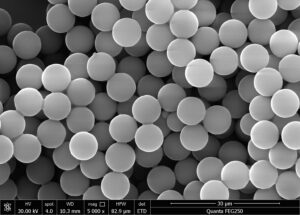
Streptomycin is a protein with similar biological characteristics to avidin. Unlike avidin, which is found in egg white, streptavidin originates from the genus Streptomyces and is a protein product secreted by Streptomyces avidin during cultivation. SA can also be produced through genetic engineering. One molecule of streptavidin binds to four molecules of biotin, and the interaction between the two is one of the strongest non covalent binding forces known in nature.
Streptomycin does not contain glycosyl side chains on its surface, and its isoelectric point is closer to neutral, which is conducive to biological reactions. Therefore, its sensitivity and specificity in detection are higher than those of streptavidin, making it more advantageous in applications.
بالإضافة إلى ذلك، يوجد نوع فريد من الخرز المغناطيسي ذي الألفة المحايدة، والذي يتميز بنقطة كهربائية محايدة وخصائص إزالة الجليكوزيل، دون تسلسل التعرف على RYD. لذلك، يكون ارتباطه غير النوعي أقل عادةً من ارتباط الأفيدين والستربتافيدين، ويحافظ على أعلى نشاط نوعي تجاه بروتينات ربط البيوتين. تتمتع الخرز المغناطيسي ذي الألفة المحايدة بأدنى ارتباط غير نوعي ولا تقلل من تقارب البيوتين.

تطبيق ستريبتمتعطشفي الخرز المغناطيسي
-
الكيمياء الضوئية
streptavidin magnetic beads are very easy to use. After purchase, they are cleaned and diluted to become a component of the luminescent reagent. By mixing with biotinylated antibodies to form a solid-phase capture surface, the target substance in the sample can be captured. The advantages of this system, in addition to the high affinity and amplification effect mentioned earlier, are that biotinylated antibodies are simple and biotin molecules are small, and coupling with antigens/antibodies does not affect protein activity.
There are various commercially available biotinylated reagents available, with the most commonly used being biotinylated molecules containing NHS esters, which rely on the side chains of biotin to form various reactive groups that can react and bind with other molecules (carrying amino, carboxyl, thiol, etc.).
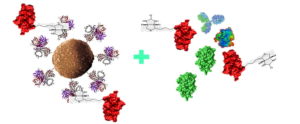
- الالتقاط المستهدف
Targeted capture sequencing is the process of isolating and enriching target genes from the entire genome, and then using high-throughput sequencing (NGS), which is widely used in health screening, clinical testing, and other applications with high sensitivity. At present, targeted capture sequencing mainly uses liquid-phase capture methods, where biotin carrying probes hybridize with the target region and then bind to streptavidin magnetic beads to achieve capture.
Other fragments are washed off, and then the probes are separated from the target fragments by denaturation. Magnetic separation removes the magnetic beads and empty probes bound to them, completing the capture of the target region. Streptavidin magnetic beads are one of the important raw materials for liquid-phase hybridization capture.
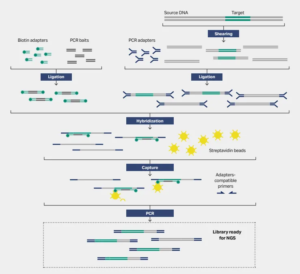
-
الترسيب المناعي
Immunoprecipitation (IP) is a classic method for studying protein interactions based on the specific interaction between antibodies and antigens. Treating a protein as an antigen and using known antibodies against it to precipitate and separate it from a mixed system to achieve preliminary extraction and purification is a method used for separating and detecting specific proteins. In addition to the common Protein A or Protein G magnetic beads, streptavidin magnetic beads are also an option, which only requires biotinylation of antibodies before immunoprecipitation, and then separation and purification using streptavidin magnetic beads.
At the same time, streptavidin magnetic beads are suitable for all types of Pull down reactions, especially for antibodies that cannot bind to Protein A/G, and are therefore widely used in sample preparation and detection development for proteomics applications. In addition, due to the very low non-specific binding of streptavidin magnetic beads, they can also be used in mass spectrometry analysis.
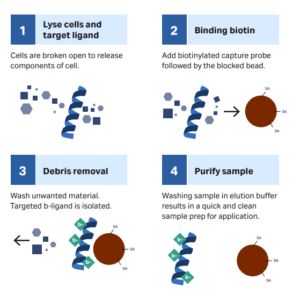
- فصل الخلايا
A technique that primarily separates a specific subpopulation of cells from a mixed cell sample based on their characteristics. In clinical analysis, whether it is tissue biopsy or blood sampling, cell separation is a critical step because patient derived samples produce complex mixtures composed of a wide range of cell types, matrices, and biological factors. At present, magnetic bead based analyte capture has become a widely used method in cell separation. Through simple magnetic manipulation, it can highly specifically capture target cell populations.
In this process, antibodies are first biotinylated, and magnetic beads bind to biotinylated antibodies through streptavidin, achieving specific binding to the corresponding antigens on the cell surface and indirectly capturing cells by magnetic beads, thus achieving separation. The ideal magnetic beads should not only facilitate cell separation, but also be compatible with a wide range of downstream applications and analyses.

طريقة ربط حبيبات الستربتافيدين المغناطيسية بالأهداف:
According to the different target molecules captured and downstream applications, direct or indirect methods can be chosen to capture target molecules. The direct method is to first bind the biotinylated ligand to streptavidin magnetic beads, then incubate with the sample, and finally capture the target through magnetic separation.
It is usually suitable for rapid detection of targets. The indirect method involves the biotinylated ligand first binding to the target molecule in the sample to form a complex, which is then co incubated with streptavidin magnetic beads. After magnetic separation, the target molecule is captured. The indirect method is suitable for experiments with low target concentration, weak specific affinity, or slow binding kinetics, such as NGS targeted capture sequencing applications.
يمكن أن توفر SHBC حبيبات مغناطيسية من ستريبتافيدين ذات أحجام موحدة ومغناطيسية فائقة. يمكن أن ترتبط ستريبتافيدين الوفيرة على السطح بكفاءة بالجزيئات البيوتينية، بما في ذلك الحمض النووي، والحمض النووي الريبي، ومنتجات تفاعل البوليميراز المتسلسل، والأجسام المضادة، والببتيدات، والبروتينات الأخرى. تحت تأثير مجال مغناطيسي خارجي، يتم امتصاص حبيبات ستريبتافيدين المغناطيسية، وبالتالي تنفصل عن الجزيئات غير المستهدفة في العينة وتحقق التقاط الجزيئات المستهدفة. في الوقت الحاضر، تُستخدم حبيبات ستريبتافيدين المغناطيسية بشكل أساسي في تطبيقات البحث مثل التقاط الأحماض النووية، وفصل البروتينات، وفرز الخلايا، والتحليل المناعي، والتسلسل المستهدف.

